The animal kingdom boasts of many unusual and exotic creatures, with interesting physical and personality traits.
In this article, we’ve compiled a list of 25 different animals with big heads. Their common point is their large head size, but they also have their unique qualities.
Some big head animals are the African elephant, the horse, the bison, the beluga whale, and the gorilla.
Let’s take a look at all the animals compiled. We’ll focus on their habitat, range, diet, and any other crucial information needed on these big-headed animals.
List of Animals with Big Heads
1. African Elephant
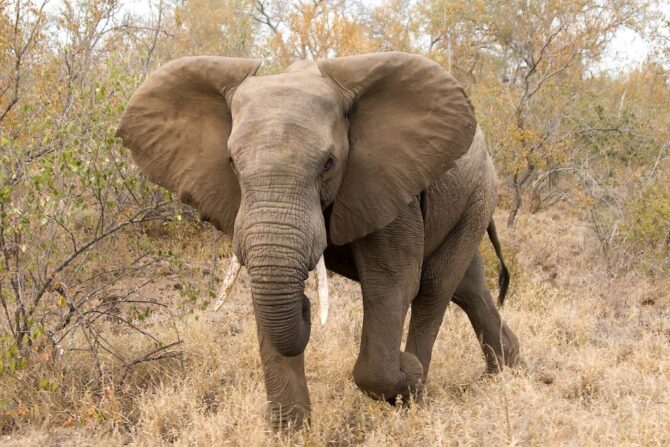
- Scientific Name: Loxodonta
- Range: Africa
- Habitat: Forest
- Diet: Herbivore
- Conservation Status: Endangered and critically endangered
The African elephant is a genus that comprises two elephant species: the African bush elephant and the African forest elephant. These two add up to the Asian elephant being the only three elephant species in existence today.
The elephant (all species combined) is the largest existing land animal today, so it’s no surprise that its head would be big. The African elephant is often found in forest areas of Africa and is a herbivore.
This animal is very social and can be found in herds of ten or twenty led by the oldest female. Unfortunately, all three elephant species are endangered, one critically so.
2. Anglerfish
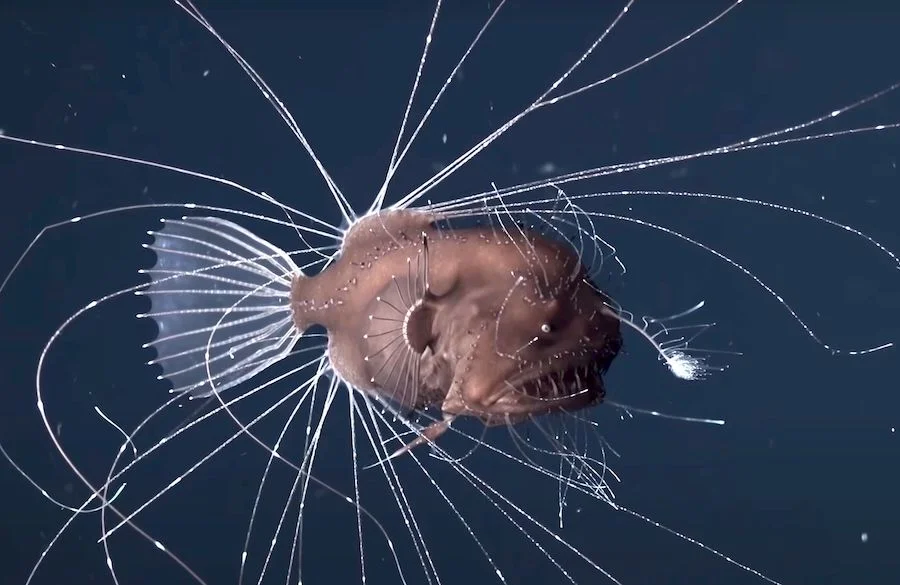
- Scientific Name: Lophiiformes
- Range: Worldwide
- Habitat: Atlantic and Antarctic oceans
- Diet: Carnivore
- Conservation Status: Critically endangered
The anglerfish looks small, or so a potential prey thinks. The dorsal fin which makes up its head is deceitful and stays small till it’s time to eat.
That’s when the anglerfish reveals its huge jaws, and the prey says goodbye to living. This fish’s head is unusual. Anglerfishes live in saltwater, namely oceans like the Atlantic and Antarctic.
There are different anglerfish species, and they occur worldwide. However, some sources have it that the anglerfish is endangered.
3. Bison
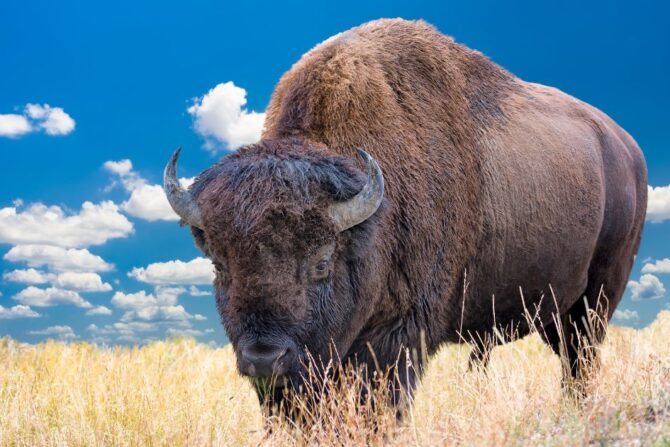
- Scientific Name: Bison
- Range: North America, Europe
- Habitat: Grasslands and open savannah
- Diet: Herbivore
- Conservation Status: Near Threatened
There are only two existing bison species in the world today, the American bison and the European bison. Other bison species are considered extinct. The remaining two species faced extinction too, but are currently listed as “Near Threatened”.
Bison are big, including their heads. However, they run faster than they appear. The speed can get up to 40mph, which is more than the fastest human record.
These animals are herbivores and are considered important for the ecosystem because their grazing keeps grasslands healthy and the dropping is manure.
4. Beluga Whale

- Scientific Name: Delphinapterus leucas
- Range: Russia, Canada, and Greenland
- Habitat: Arctic ocean, North Atlantic Ocean
- Diet: Carnivore
- Conservation Status: Least Concern
The Beluga whale also goes by three names: the white whale, the sea canary, and the melonhead. These names aren’t random. It is called the white whale because of its color, the sea canary due to the sound it makes, and the melonhead because of its…head.
The Beluga whale is small compared to other whales, but it makes up for that by having a big head. It can be found in oceans in Russia, Canada, and Greenland.
As a carnivore, the Beluga whale feeds on fish, crustaceans, and marine animals. Beluga whales are social creatures and communicate with themselves.
5. Gorilla
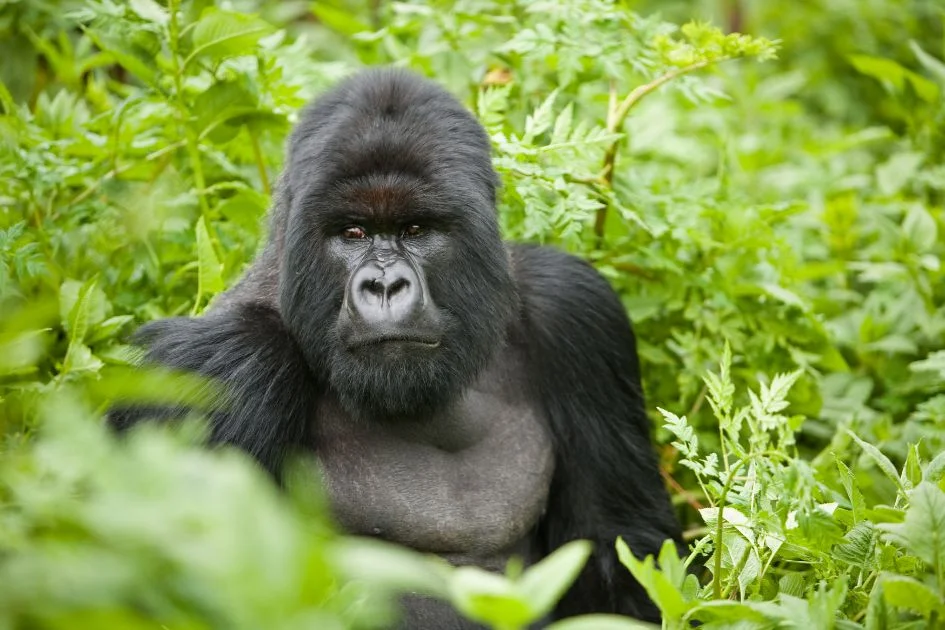
- Scientific Name: Gorilla
- Range: Equatorial Africa
- Habitat: Forests
- Diet: Herbivore
- Conservation Status: Critically Endangered
Gorillas living today can be divided into two: the eastern gorilla and the western gorilla. They are the largest living primates today but are sadly at risk of extinction. As big animals, gorillas also have big heads.
The gorilla is found in Africa where it inhabits rainforests. It lives a simple life, and its days are filled with eating and resting. It is a social animal, often found in troops of 5 to 35. The leader is usually the oldest male.
6. Blue Whale
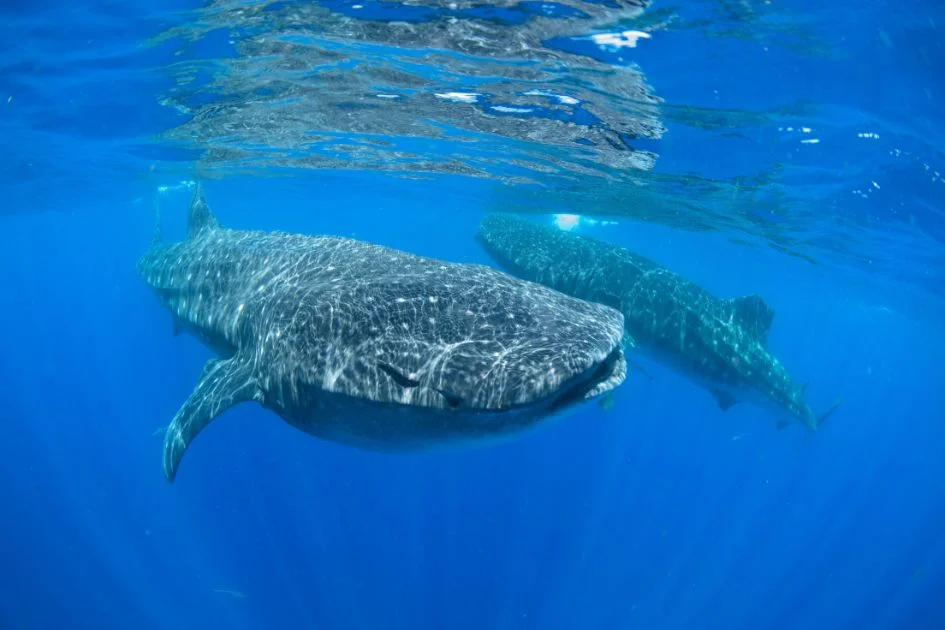
- Scientific Name: Balenoptera musculus
- Range: Eastern Canada
- Habitat: Oceans
- Diet: Omnivore
- Conservation Status: Endangered
The blue whale holds the title of the largest animal in the world, and could once be found in all the world’s oceans. Sadly, that changed when whale hunting got to the extreme, so much that the International Whaling Commission banned the hunting of blue whales in 1966.
The blue whale has managed to exist since then, but it is still considered an endangered species. This marine mammal is an omnivore and feeds with a style known as skim feeding.
Rather than teeth, the blue whale has baleens which it uses to filter food from water that it swallows. While it often lives in solitude, it can stay in pairs.
7. Bowhead Whale

- Scientific Name: Balaena mysticetus
- Range: Eastern Greenland and Spitsbergen
- Habitat: Arctic ocean
- Diet: Herbivore
- Conservation Status: Least Concern
The bowhead whale isn’t as big as the blue whale, but it has a very big head and is the biggest baleen one can find on a whale. Its mouth is also the biggest amongst animals in general.
The bowhead whale’s population was affected by the increase in whale hunting in times past, but unlike the blue whale, it is not endangered at the moment.
The bowhead whale’s big head is for a good reason. This marine mammal has a big brain, and that helps it navigate the ocean. Another special quality of this whale is its long lifespan. The bowhead whale can live up to 200 years!
8. Grizzly Bear

- Scientific Name: Ursus arctos horribilis
- Range: Alaska and Western Canada
- Habitat: Woodlands, forests, alpine meadows, prairies
- Diet: Omnivore
- Conservation Status: Least Concern
The grizzly bear (or simply grizzly) is the North American brown bear species, and due to this, it is also called the North American brown bear. Its head is large, and this isn’t a bear you’d want to meet alone in the woods. The grizzly bear can be very aggressive.
Its diet is wide as it is an omnivore, so the grizzly bear can eat a lot of animals and plants. The animals include small mammals, fish, and insects.
The grizzly bear inhabits woods, prairies, and other related habitats. While it tends to avoid human contact, it can get wild. Its lifespan is 25 years.
9. Green Humphead Parrotfish
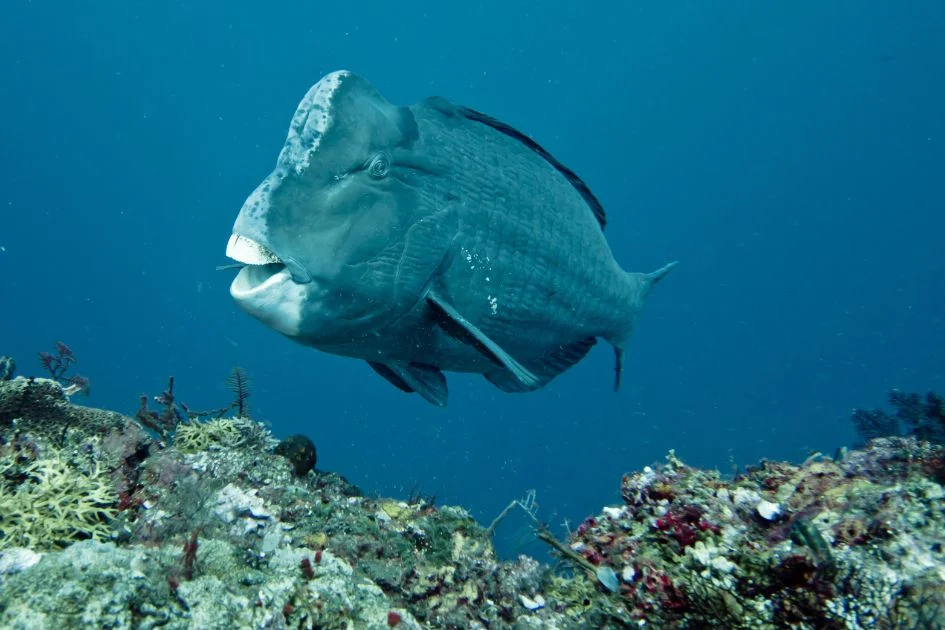
- Scientific Name: Bolbometopon muricatum
- Range: Australia
- Habitat: Reefs
- Diet: Omnivore
- Conservation Status: Vulnerable
The green humphead parrotfish is the largest parrotfish species among about 90 them.
It is also called the bump head parrotfish, humphead parrotfish, double-headed parrotfish, buffalo parrotfish, and the giant parrotfish. It can be found on reefs of oceans, specifically the Indian and Pacific.
This fish feeds on both plants and animals, including algae, coral, and small invertebrates. Overfishing is a problem for the green humphead parrotfish, and it is vulnerable. Its main name points to the large head size.
10. Hippopotamus

- Scientific Name: Hippopotamus amphibius
- Range: Africa
- Habitat: Rivers, lakes, mangrove swamps
- Diet: Omnivore
- Conservation Status: Vulnerable
Also called the hippo, common hippopotamus, or river hippopotamus, this is one of the largest mammals, and it is semi-aquatic.
The name is derived from both ancient Greek and Latin words that mean “river horse.” It can be found in Africa where it lives in rivers, lakes, and mangrove swamps.
Hippos are known to be aggressive, and with the high rate of attacks it has carried out, it is considered the second deadliest mammals, surpassed only by humans. It is vulnerable now because of habitat loss and poaching.
11. Horse

- Scientific Name: Equus caballus
- Range: Worldwide
- Habitat: Plains, prairies, and steppes
- Diet: Herbivore
- Conservation Status: Domesticated
While there are wild horses still in existence today, many are now domestic and live in the care of humans. This domestication happened 6,000 years ago, according to archeological evidence.
The horse is currently one of the most popular animals, and it can be found worldwide. Domestic horses can adapt anywhere, but wild horses stay on plains, prairies, and steppes.
Horses feed only on plants, but contrary to myths, they are not ruminants. They deserve credit for all the roles they’ve played for humans as pets, work animals, transport, sports, and even war companions in historical moments.
12. Hammer-headed Bat
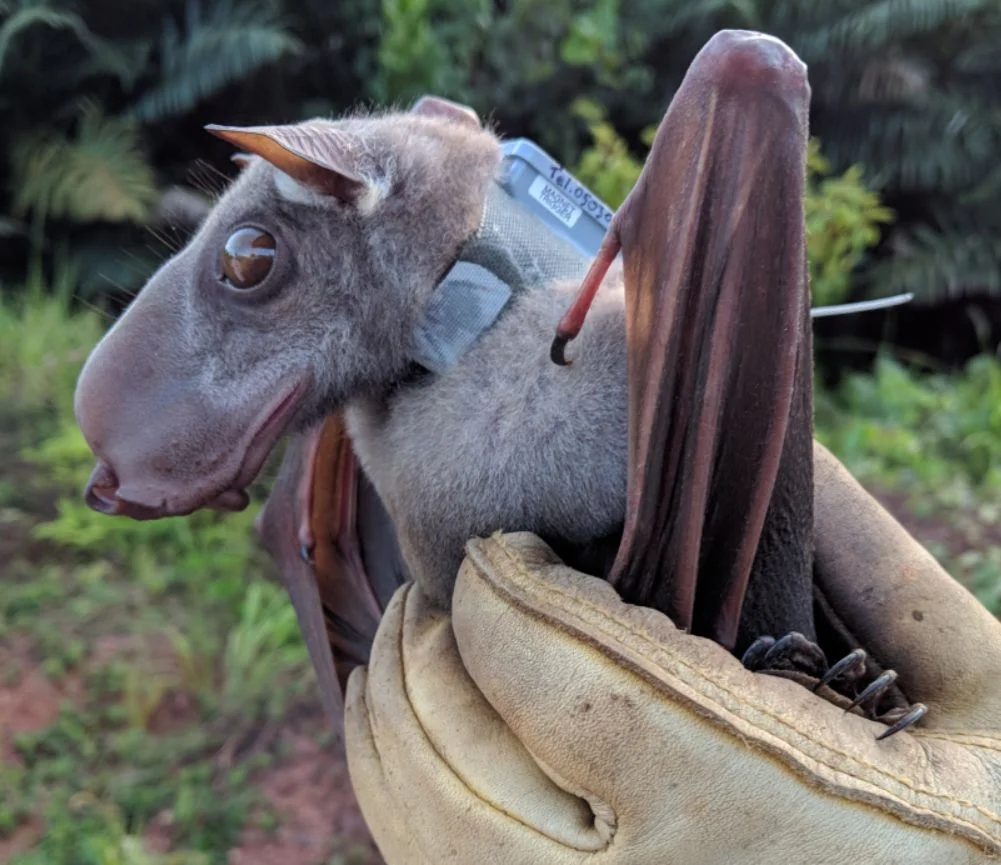
- Scientific Name: Hypsignathus monstrosus
- Range: Africa
- Habitat: Tropical rainforests, woodlands
- Diet: frugivore
- Conservation Status: Least Concern
The hammer-headed bat is also known as the hammer-headed fruit bat and big-lipped bat.
It is popular in the west and central parts of Africa, where it dwells in rainforests and woodlands. The hammer-headed bat is the largest in Africa, and it does have a hammerhead.
While some members of this species have fed on plants, this bat feeds more on fruits—similar to many other bats. The fruits include mangoes, figs, and bananas.
13. Koala
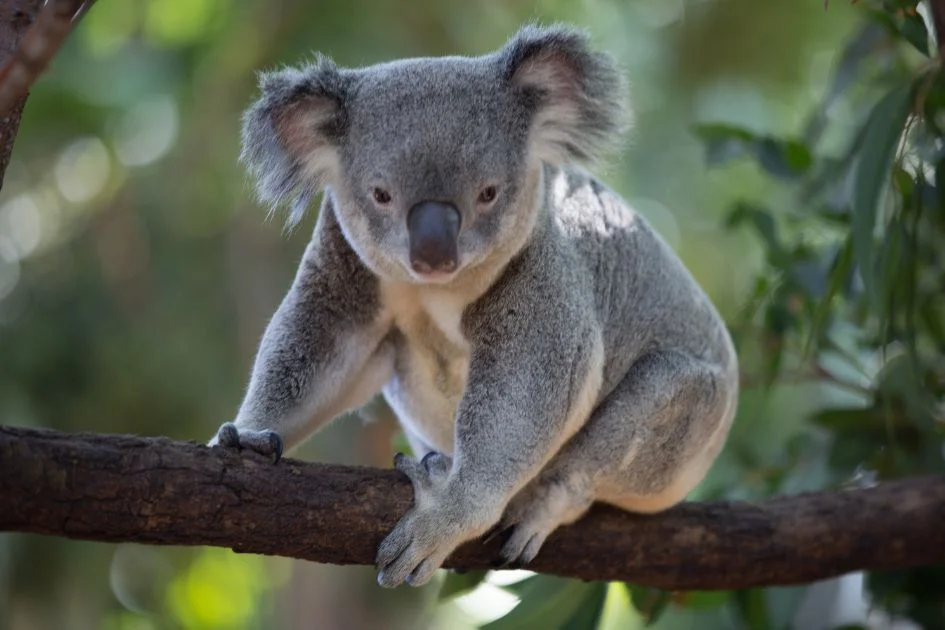
- Scientific Name: Phascolarctos cinereus
- Range: Southeastern and eastern Australia
- Habitat: Forests
- Diet: Herbivore
- Conservation Status: Vulnerable
The koala is a small animal with a big head that has become a popular image for stuffed toys. It can be found in Australia where it lives on trees in forests. The koala is easily recognized by its looks.
Stout, no tails, round and fluffy ears with the big head that made it part of this list. As arboreal animals, koalas are herbivores.
They often feed on eucalypt trees, but they can also be found on Acacia and a couple of other trees. Koalas are more active at night, and during the day they’re often found resting on trees.
14. Musk Ox

- Scientific Name: Ovibos moschatus
- Range: Northern Canada, Greenland
- Habitat: Arctic
- Diet: Herbivore
- Conservation Status: Least Concern
The musk ox adapts to cold regions, and it can be found in those parts of Canada and Greenland. It is big-headed and known for the signature odor the males emit to attract females during the mating season (also known as the seasonal rut). This is why it was named the musk ox.
Musk oxen are social animals that live in herds of 12 to 24 in the winter, while in summer they rearrange into groups of 8 to 20. They are herbivores, feeding on grasses, mosses, and lichens.
15. Lion (Male)
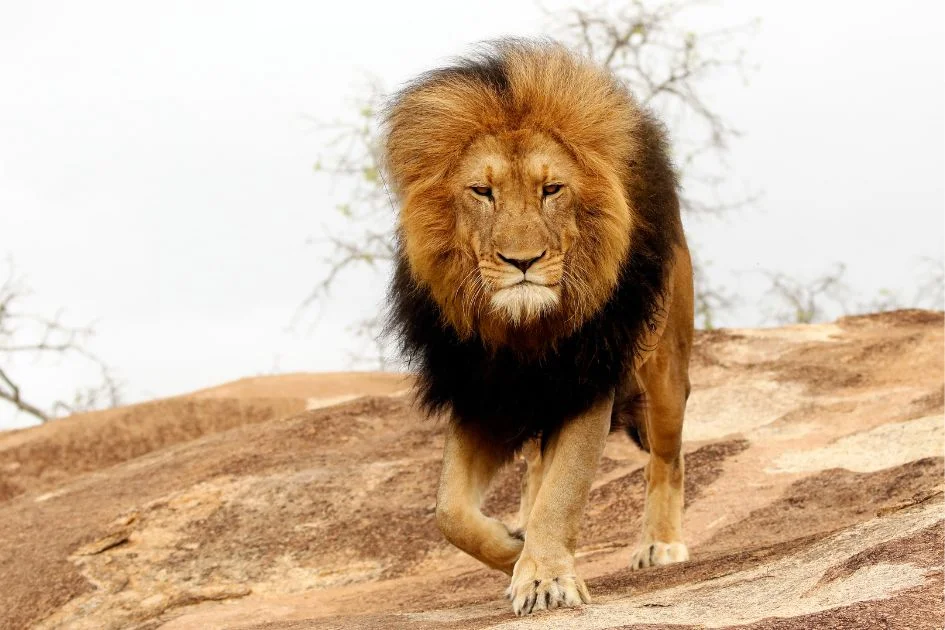
- Scientific Name: Panthera leo
- Range: Africa
- Habitat: Grasslands, shrublands, savannah
- Diet: Carnivore
- Conservation Status: Vulnerable
Who doesn’t know the king of the jungle? The lion is a member of the cat family and is often termed a large cat.
There’s a big difference between the male and the female, including the head size. The male is the only one with a big head and manes. Lions are obvious carnivores and apex predators, capable of hunting animals bigger than they are.
The only enemies of lions are humans. The lion is mainly found in Africa, but it can also be sighted on other continents. It is considered vulnerable possibly due to habitat loss and conflict with humans.
16. Orangutan (Male)
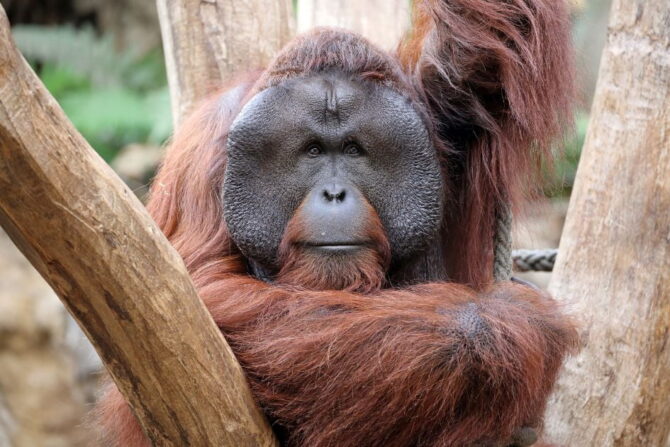
- Scientific Name: Pongo
- Range: Asia
- Habitat: Rainforests
- Diet: Omnivorous
- Conservation Status: Critically endangered
The orangutan was first regarded as one specie. Over time, it got split into two: the Bornean orangutan and the Sumatran orangutan.
In 2017, a third orangutan species was classified. That was the Tapanuli orangutan. Sadly, all three orangutans are critically endangered due to habitat loss and poaching.
Orangutans are omnivores. Though their main diet is plant-based, they will also feed on insects and small animals if need be. Their heads are big, especially when compared to the remaining parts of their bodies.
17. Octopus

- Scientific Name: Octopoda
- Range: Worldwide
- Habitat: Ocean
- Diet: Carnivore
- Conservation Status: Endangered
The octopus is an easily recognizable marine animal that can be found in both salt and fresh water. Its distinct features include eight limbs and a big head.
The octopus is a cephalopod (from the class Cephalopoda) alongside squids, nautiloids, and cuttlefishes. Amongst invertebrates, the octopus and other cephalopods are considered the most intelligent.
The octopus also has strong eyesight and is a predator. It feeds on crustaceans, whelks, clams, prawns, etc. Octopuses are good at camouflage too, and they live solitary lives.
18. Panda
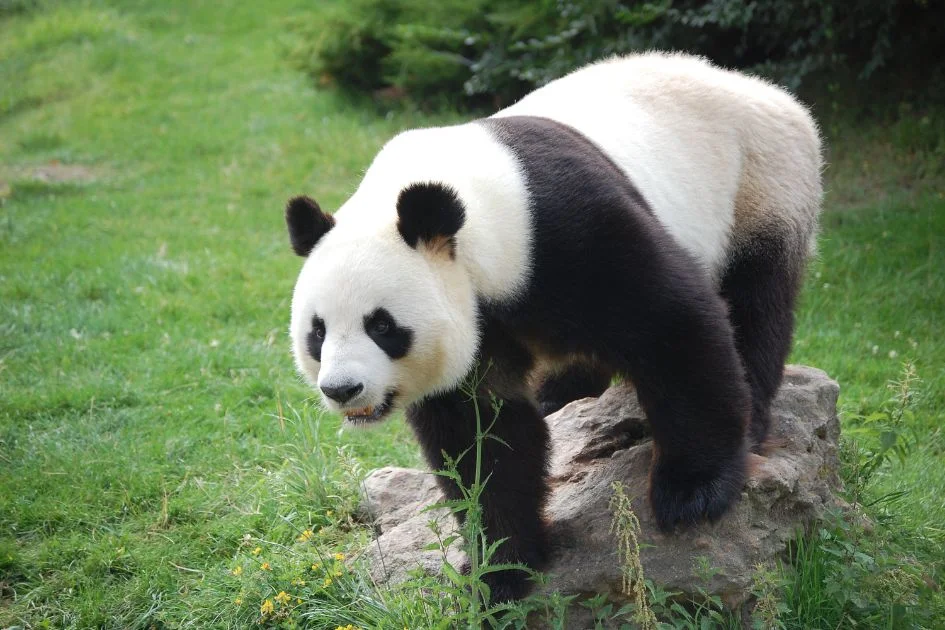
- Scientific Name: Ailuropeda melanoleuca
- Range: southwest China
- Habitat: Forests
- Diet: Herbivore
- Conservation Status: Vulnerable
The panda can only be found in China, and it has become a significant symbol to the Chinese population. You won’t be able to think of China without considering pandas. It has a big head and the characteristic black-and-white skin.
Pandas live in bamboo forests where they feed on bamboo. However, some are known to be omnivores and feed on animals. Pandas in captivity can adapt to eating eggs, honey, fish, yams, and fruits.
19. Owl

- Scientific Name: Strigiformes
- Range: Worldwide
- Habitat: Forests,
- Diet: Carnivore
- Conservation Status: Endangered, Vulnerable
There are over 200 owl species in existence today, spread all over the world except Antarctica. A couple of them are considered endangered and vulnerable due to multiple reasons like habitat loss and hunting.
The high number of owls and the worldwide spread led to them being increasingly popular. Many people can recognize the talons, big heads, eyes, and glorious feathers.
It also has a strong vision, being a nocturnal bird. However, not all owls are nocturnal. The northern hawk oil and the gregarious burrowing owl are diurnal. Owls feed on mice, insects, and birds.
20. Shrews
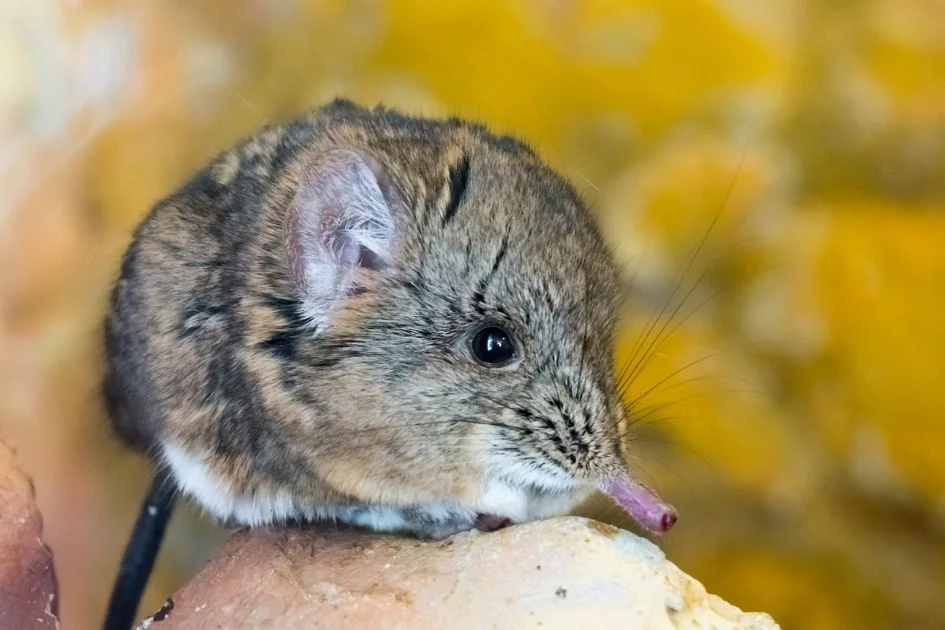
- Scientific Name: Soricidae
- Range: North America, South America, Africa
- Habitat: Tropical and temperate
- Diet: Omnivore
- Conservation Status: Least Concern
The shrew resembles rats and mice, and it often gets categorized as a rodent because of this. However, the shrew is not a rodent, though it is related to them.
The shrew is characterized by a bigger head on a small body. They are all small, the biggest being up to 6 inches long. The smallest terrestrial mammal in the world today is a shrew.
Shrews are highly territorial and have a strong spirit underneath their small bodies. Some shrews dig burrows, and there are venomous shrew species, a trait not often found in mammals.
21. Rhinoceros
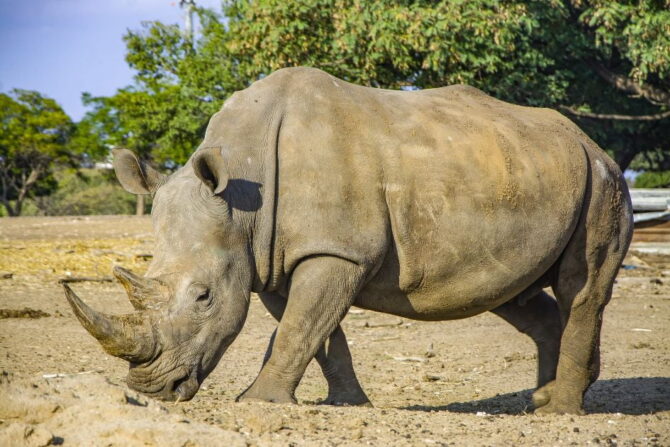
- Scientific Name: Rhinocerotidae
- Range: Africa, Asia
- Habitat: Tropical and subtropical grasslands, savannas, shrublands
- Diet: Herbivore
- Conservation Status: Near Threatened, Critically endangered
The rhinoceros consist of four known species: the black rhino, white rhino, southern white rhino, and eastern black rhino.
It is a large animal, weighing over 1,000 pounds! Undoubtedly, it has a big head. There are also horns standing out. Their size notwithstanding, the rhinoceros is prey to animals like lions and tigers.
Humans are also the rhino’s great enemy. To avoid these predators, rhinos live in areas with dense vegetation.
22. Sperm Whale
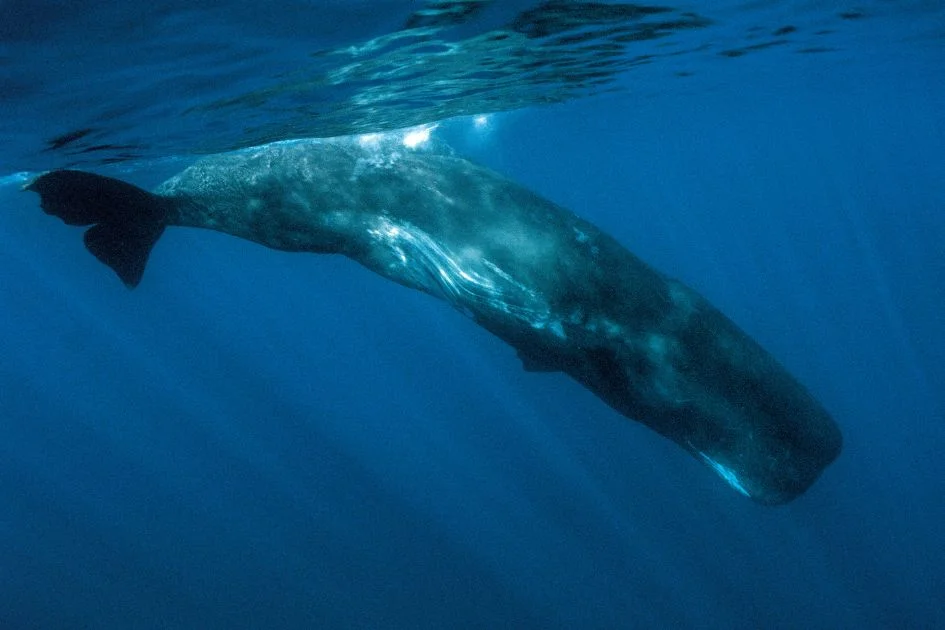
- Scientific Name: Physeter macrocephalus
- Range: All deep oceans
- Habitat: Oceans and seas
- Diet: Carnivore
- Conservation Status: Vulnerable
The sperm whale is both big-headed and very large, a characteristic of many whales in existence. They often live deep in the ocean, as deep as 3,000 feet.
You can find them in all deep oceans, though with their status being “vulnerable”, this may no longer be the case. The sperm whale is a carnivore, feeding on animals like the giant squid, the colossal squid, the octopus, and even sharks.
It has few predators because of its size, though it is sometimes preyed upon by killer whales when weak. Sperm whales are migratory, the young ones live in groups while older ones are solitary.
23. Tarsier

- Scientific Name: Tarsiidae
- Range: Philippines
- Habitat: Rainforests
- Diet: Herbivore
- Conservation Status: Endangered
Tarsiers inhabit the rainforests in Southeast Asia, specifically the Philippines. It is recognizable by its big head and eyes, alongside the long fingers and toes that it uses to grab onto trees.
Tarsier species once had a wider range, but due to the reduced population, it is now confined to Asia.
The tarsier is an insectivore, feeding on prey like beetles, cockroaches, and grasshoppers. It can also eat arachnids. They are prey as well, and its enemies include birds, snakes, bats, and lizards.
24. Napoleon Fish

- Scientific Name: Cheilinus undulatus
- Range: Oceans and seas
- Habitat: Indo-Pacific ocean
- Diet: Carnivore
- Conservation Status: Endangered
The Napoleon fish also goes by the names humphead wrasse, Māori wrasse, the Napoleon wrasse, so mei, merer, and mameng.
It is the biggest member of its family, and due to its large size, the Napoleon fish has a big head. It also has big eyes, thick lips two lines behind the eyes (both black), and a hump on the forehead.
This fish lives for a very long while, getting up to 30 years. However, it takes some time for it to breed. It reaches sexual maturity at 5 to 7 years and is known to change sex.
25. Bald Uakari
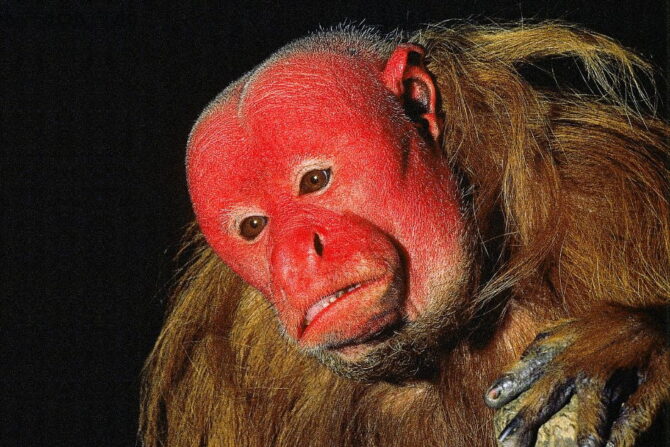
- Scientific Name: Cacajao calvus
- Range: Brazil, Peru
- Habitat: Amazon River basin
- Diet: Omnivore
- Conservation Status: Vulnerable
The last big head animal on this list is the bald uakari, an unusual monkey with an interesting name. The bald uakari is also known as the bald-headed uakari, and its prominent feature is the big, bald head.
It also has a short tail, a bright crimson face, and a long coat. Its diet is wide but predominated by seeds and fruits. Added to those are insects, buds, and flowers.
A fun fact about the bald uakari is that its unusual looks are an asset to attract the opposite sex. The redder the face, the more attractive a bald uakari is.
Also See:
30 Animals With Long Tails (Examples With Pictures)
Final Thoughts
There are many animals with big heads in the wildlife, many of which are sadly vulnerable and even endangered.
The population dwindling is to a large extent caused by human activities, and we would help preserve these interesting animals if we can respect the environment.
On land and in the sea, all these animals have a role to play in the ecosystem, besides having unique looks.
Featured Image Credit: Snic320 / Getty Images






